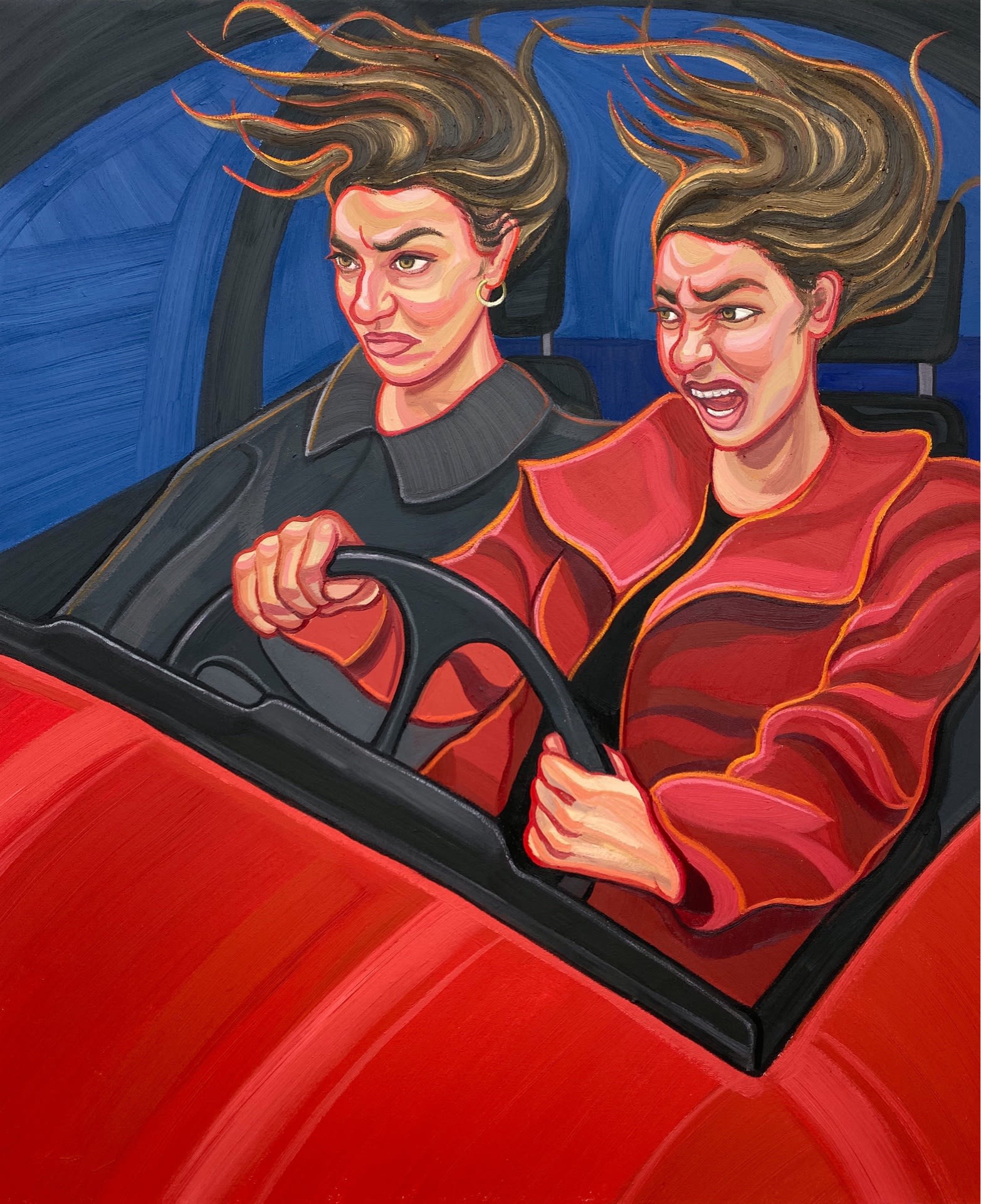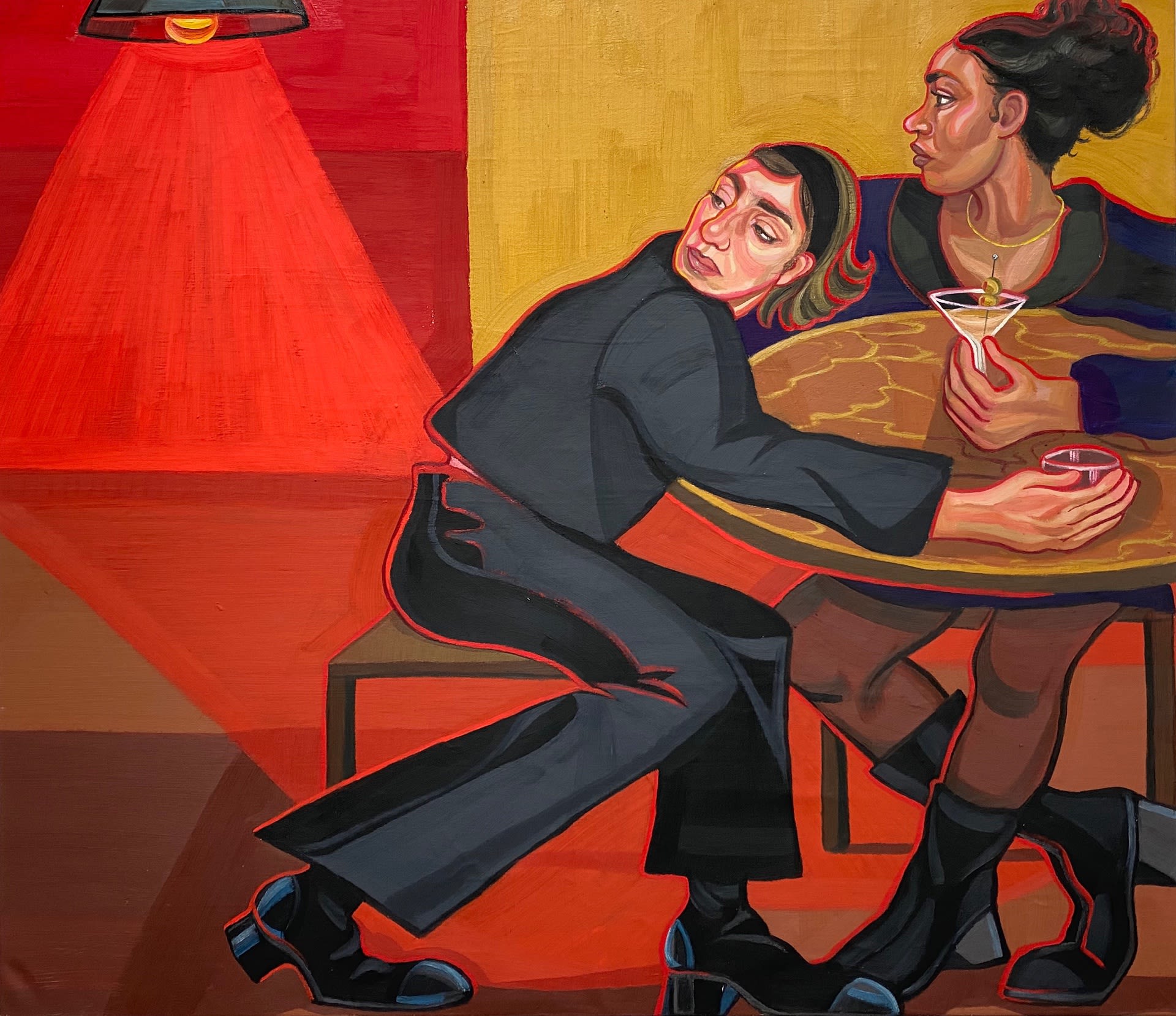ANIA HOBSON
@ANIA_HOBSON
FEATURE ANNOUNCEMENT! I am delighted to present the brand new She Curates feature with the one and only @ania_hobson
“My painting is just another, more primal form of expressing language to me, and one that sometimes subconsciously realises my own anxieties. But I want people to interpret the paintings in their own way, perhaps reading their own lives into my figures.
This is why I enhance and exaggerate my characters’ expressions, it’s a way for me to draw the viewer in and getting them to dig into a feeling they recognise or maybe even still hold whilst they’re in front of the work, I’m trying to build that connection between me, the painting and you…”
-
INTERVIEW
ANIA IT IS SUCH A THRILL TO SPEAK TO YOU ABOUT YOUR WORK. LET'S START WITH A SMALL ONE - How would you describe what you do in 3 words?
Can they be compound words? If so,
ABSOLUTELY!
People-watching
Psycho-analysing
Shape-making
PEOPLE WATCHING IS MY FAVOURITE ELEMENT OF YOUR WORK. YOU SEEM TO CATCH THE SUBJECTS IN MOMENTS THAT MIGHT GET OVERLOOKED. Your work to me is so many things! Its intensity, but intimacy, and the extraordinary in the ordinary… What do you hope your work says?
I like to think that my work brings out emotions in people, ones that they can remember having, painting scenes and situations that feel familiar although they’re not. My painting is just another, more primal form of expressing language to me, and one that sometimes subconsciously realises my own anxieties. But I want people to interpret the paintings in their own way, perhaps reading their own lives into my figures.
THAT'S INCREDIBLE.
This is why I enhance and exaggerate my characters’ expressions, it’s a way for me to draw the viewer in and getting them to dig into a feeling they recognise or maybe even still hold whilst they’re in front of the work, I’m trying to build that connection between me, the painting and you…
SO INTERESTING, ESPECIALLY IN YOUR RECENT WORKS YOU ARE LITERALLY PULLED INTO THE SCENE, THE MOMENT THEY ARE EXPERIENCING. What do you believe is the most important aspect of your work, and the core of your practice?
The most important aspect of my work is that I keep it true to myself, and that I’m always going further and evolving my ideas. My painting aesthetic develops naturally over time, but it’s also a timeline of my own experiences and life. My colour palette can change with my mood, and my faces can become more visceral and expressive. I learn a lot from my older works and sometimes when I’m working on a new painting I will put an older painting next to me to help me with the new one. I might’ve grown to dislike an older work but I like to think I can learn something new from it.
IN THAT RESPECT, Could you select a piece of your work and tell me a bit about it Ania?
‘Two Moods’ - The girl in red represents anger and frustration, the girl in black represents determination and accepting the ‘death’ of something she’s had to force herself to leave behind. Both those combined are the start of a fast, new journey. I find I can experience such a variety of emotions when I’m driving a distance, alone in my car. Whether it’s an anxiety, escapism, a sadness of something we’ve left behind, or even the nervous anticipated start of something new. I also decided to place these two dualities inside a fast moving car as being in one can fill you with fear, but for some it can be an addictive rush of adrenaline and excitement. I felt it suited the mood of this painting perfectly.
-

I also decided to place these two dualities inside a fast moving car as being in one can fill you with fear, but for some it can be an addictive rush of adrenaline and excitement. I felt it suited the mood of this painting perfectly.
-
MY FAVOURITE PIECE. What is one thing people would be surprised to know about you?
I sometimes say to myself that if my painting hadn’t taken me to where I am now that I would’ve trained to become a wildlife researcher - which is the background of both my zoologist parents. I am permanently fascinated by how wildlife interacts with its environment, a world hidden for many of us, and with so much to learn and still to be discovered. I think I still have a romantic vision that one day I might find myself crawling through a dark jungle somewhere, equipment on my back and binoculars in my hand.
If you could have a meal with any artist from any time, what would the meal be and who would it be with?
It would definitely be Salvador Dali! I have one of his recipe cook books where he presents dishes in typical surrealist style where leek pies appear as palm trees and cooked crayfish are presented as a forests of trees. He was well known for putting on these weird freakish dinner parties, so to have been a guest at one of them must have been an amazing experience.
-
YOUR FIGURES AND SUBJECTS SAY SO MUCH IN THE SPACE THEY OCCUPY... Tell me a bit about the figures in your work; who are they? What are they feeling?
In my past work and in some of my current paintings a lot of my figures are my friends and my family, although often they don’t bear resemblance to them in the finished painting. I use them as models because they are usually reasonably happy to be made to march around my studio wearing hats and coats that I’ve directed them to wear. They have to either act out or pose in a way that might not feel natural or comfortable to them, but they’ve learnt to understand my methods. I found having people that are close to me model for me put less pressure on the situation and makes it a more comfortable experience.
Recently though, I have stopped using models so much and now I use my sketch book contents, because I find it frees up my hand. I did for a period in the past study very traditional technique. So I’ve found when I’m not drawing from life it allows me to keep my figures less anatomically correct, which is what I like. It’s more challenging in other ways to use my mind’s eye, and I don’t particularly visually enjoy anatomical proportions to be correct in painting - I prefer to create more of a dream-like vision where perhaps a familiar person you might have been dreaming of never really looks like who they really are... I find the distortion that naturally happens when I sketch, helps emphasise and exaggerate the emotions the figures represent.
Do you have any shows or exhibitions coming up that we should be aware of?
I have two exhibitions confirmed for 2021, a solo show with the Gillian Jason Gallery in May and a group show with Thompsons Gallery in London in March. I’ve also got some work showing at the London art fair with CATTO and some exciting residencies in Europe and group shows to look forward to.
I LOVE THIS QUESTION FROM A COMMUNITY POINT OF VIEW - WHO ARE YOUR FAVOURITE FEMALE CONTEMPORARY ARTISTS?
Kemi Onabule - @kemionabuleart
Cheyenne Julien
Kudzanai-Violet Hwami - @mwana.wevhu
Tau Lewis - @taulewis
Rachel Jones - @jo.nesr
Rebecca Ackroyd - @rebeccaackroyd
Somaya Critchlow - @somayacritchlow
Is there ANYTHING ELSE YOU WOULD LIKE TO SAY?
In all truthfulness, being able to have a presence on a platform like yours means that women-identifying artists like me and many others be more visible in what still is a very male world. Through your interviews you encourage us to shout out other artists whom we admire, and in that way we are all actually working together.
-




